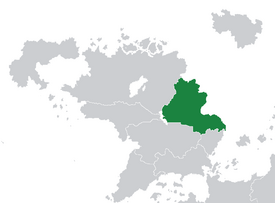Chistovodia
This article is incomplete because it is pending further input from participants, or it is a work-in-progress by one author. Please comment on this article's talk page to share your input, comments and questions. Note: To contribute to this article, you may need to seek help from the author(s) of this page. |
Chistovodian Workers' State Робоча Держава Чистовод'я Roboča Deržava Čystovodja | |
|---|---|
| Motto: "Пролетарии всех стран, соединяйтесь!" "Workers of the world, unite!" | |
| Anthem: The Internationale | |
 Chistovodia (dark green) in Asteria Superior (grey) | |
| Capital | Misto Myru |
| Largest city | Khmelnytskyi |
| Official languages | Soravian |
| Ethnic groups | Chistovodians ~ |
| Demonym(s) | Chistovodian |
| Government | Federal semi-presidential council republic. |
• President of the Presidium | Viktor Martynenko |
• Premier | Angelika Cuvillier |
| Legislature | General Congress |
| History | |
• Colonisation | 1691 |
• Soravian Civil War | 1856 |
• Independence | 1860 |
• Revolution | 1931 |
| Area | |
• | 2,399,981 km2 (926,638 sq mi) |
| Population | |
• 2015 estimate | 61,109,847 |
• Density | 25.46/km2 (65.9/sq mi) |
| GDP (nominal) | 2015 estimate |
• Per capita | $34,800 ($2.126tn.) |
| Gini (2014) | 22.1 low |
| HDI | 0.900 very high |
| Currency | Chistovodian Zolota (CZ) |
| Time zone | East Asterian Standard Time |
| Date format | dd-mm-yy |
| Driving side | right |
Chistovodia (Soravian: Чистово́д'я, tr. Čystovodja), officially the Chistovodian Workers' State (Soravian: Робоча Держава Чистовод'я, tr. Roboča Deržava Čystovodja) is a sovereign state in Asteria Superior. It borders Cassier to the north and Halland and Nuxica to the west, as well as having maritime borders with Soravia and Gaullica. With a total area of 2,399,981 km2 and a population of over 61 million people, Chistovodia is one of the larger states in Asteria Superior. Its capital is the planned, central and coastal city of Misto Myru, whilst the largest and first founded city is Khmelnytskyi on the northern coast.
The area that is now Chistovodia was inhabited by multiple native peoples, including the Pueblo Nations and the Sioux. Eucleans initially arrived by the beginning of the 16th century. These were mainly Soravian loggers, fur trappers and fisherman who were operating out of George Ruset Land, though the internal areas around Lake Mantowic were explored by east Euclean traders and navigators around the same time. By 1691 however, Narodyns had founded a major settlement -- what is now Khmelnytskyi.
Chistovodia remained the key colony of the Soravian Empire up until the First Soravian Civil War. The colony was a key supplier of arms, supplies, resources and veterans to the Seven Province Union and negotiated with Eduard Olsov to secure independence following the war. This was not honoured however and the threat of a secessionist war eventually forced Olsov, now President of Soravia, into accepting their demands for independence by 1865. For much of its early independence history, up until the mid 1920s, Chistovodia was ruled by a military junta led by Vadym Babych. Babych, initially a progressive, industrialist and modernising ruler eventually deteriorated into a paranoid tyrant and led the now expanding population of the nation into destitution and poverty. By the time of the Great War Chistovodia was arguably one of the poorest nations in Asteria Superior and fell into a civil war involving numerous factions. The victors of this civil war were the Chistovodian Section of the Workers' International, who would go on to mould the state on the lines of a Kirenian Model.
In the modern day Chistovodia is a highly developed industrial economy with a large immigrant population. It scores highly in wealth equality, healthcare, life expectancy and government transparency. A member of the Community of Nations and Association for International Socialism, Chistovodia is also a nuclear weapons state. Chistovodia is also criticised for an overly militaristic diplomatic relationship with neighbouring countries, such as Nuxica. This stems from the grievances of the historic conflict in the late 1970s.
Etymology
History
Pre-history
Native Asterian settlements
Euclean colonisation
Independence from Soravia
Babych's Republic
Chistovodian Civil War
Establishment of Council Chistovodia
War with Nuxica
Geography
Climate
Environment
Politics
Government
Chistovodia is a self-defined 'Workers' State', in that as per its constitution the state is constructed along the lines of its workers' councils. It is one of the few countries in the world to be organised along socialist thought. As a functioning council democracy that follows the Kirenian Model, its democracy differs from liberal democracies by two main features. Firstly: the system of government is composed of a hierarchy or tier of councils. At the most basic level citizens directly elect local councils, who in turn elect representatives at municipal or regional councils. These councils appoint representatives to state councils who elect the national representatives that convene at the General Congress. Secondly, there is an absence of the separation of powers found in eastern democracies, with committees of law appointed to each tier of government. Though elections are scheduled and regular; representatives are universally responsible to the voter who can exercise their rights to issue a recall election to remove unfit representatives.
Chistovodians directly elect a President of the Presidium, who serves as the head of state. The President of the Presidium is authorised to appoint members of the General Congress to fill the seats of his or her Presidium, essentially mirroring the feature of a cabinet in liberal democracies.
As per the the constitution political parties are banned in Chistovodia, owing to the "development of factionalism, tribalism and stagnation in government" and instead there is a singular "movement" permitted by the government. This is the Chistovodian Section of the Workers' International; and though functionally a party, is regarded as a "societal movement". Whilst many individuals outside of the country may perceive it to operate as a political party; its internal factionalism ranges from hard-line Nemtsovites to democratic socialists and from Tretyakists to anarchists.


